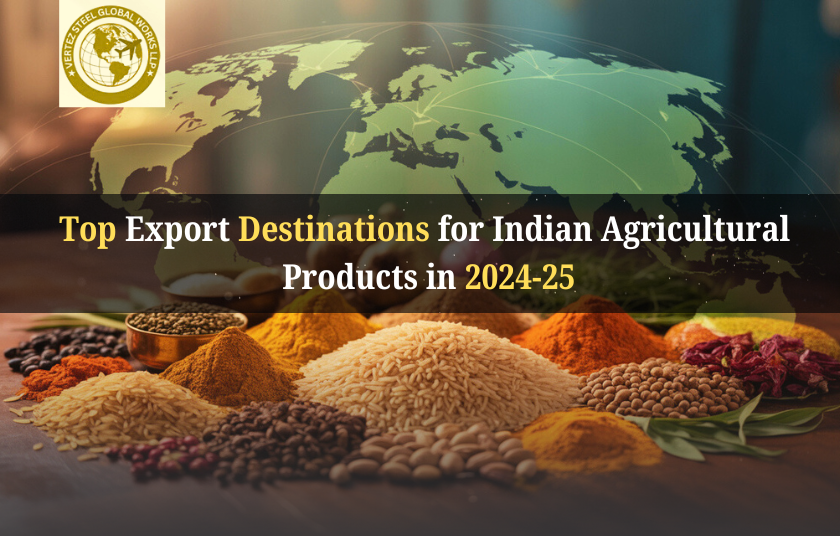Top Export Destinations for Indian Agricultural Products in 2024-25
India’s agricultural sector has long been a backbone of the economy, but 2024‑25 marks a significant chapter in its global trade story. Picture cargo ships loaded with rice, spices, pulses, tea, and organic produce, heading toward faraway ports. The question isn’t just “Where do these products go?” but “Why do these markets prefer Indian exports, and what makes each destination unique?” Understanding the agriculture export India landscape offers insight not only into trade numbers but also into strategies, buyer preferences, and global opportunities.
India’s Agricultural Export Landscape: The Bigger Picture
India exports a wide variety of agricultural products — staples like rice, wheat, and pulses, spices including turmeric, chili, and cardamom, beverages like tea and coffee, and an increasing share of organic agricultural exports. Over the past few years, the sector has grown at a CAGR of 7–8%, reflecting both rising international demand and improvements in quality and compliance standards.
Value-added and organic exports are carving out premium market segments. For instance, a cooperative producing turmeric in Tamil Nadu successfully secured European buyers by investing in traceable supply chains and organic certification. This approach not only increased revenue but positioned the product as a reliable, high-quality commodity in international markets.
Top Export Destinations for Indian Agricultural Products
The following section breaks down India’s leading agricultural export markets, highlighting specialties, trade volume, and annual import “footfall” to provide a clear, educational perspective.
1. United States
Specialties: Spices, rice, tea, pulses, ready-to-eat packaged foods.
Annual Trade Footfall: India exports roughly $5–6 billion worth of agricultural products to the US yearly.
Why it’s a top market: The large Indian diaspora and growing demand for ethnic and organic foods drive the US market. Health-conscious consumers increasingly seek spices and natural products.
Example: A small organic rice brand from Punjab entered US retail chains by leveraging non-GMO certification and eco-friendly packaging. This illustrates how compliance and product positioning can win premium buyers.
2. United Arab Emirates (UAE)
Specialties: Rice, pulses, sugar, processed foods, spices.
Annual Trade Footfall: Nearly $3 billion in Indian agri-exports per year.
Why it’s important: UAE serves as a re-export hub to Africa and Asia, making it strategic for volume-based exporters. Ports like Jebel Ali offer fast, reliable logistics.
Example: Exporters of Basmati rice can reach African markets indirectly via UAE warehouses, reducing transit delays and costs.
3. China
Specialties: Oilseeds, cotton, pulses, marine products.
Annual Trade Footfall: Approximately $2.5 billion in agricultural imports from India.
Trade Insights: China’s consumption for oilseeds and pulses has surged, particularly in northern provinces. Indian exporters benefit from preferential trade corridors and tariff agreements.
Example: A pulse cooperative from Madhya Pradesh managed to secure a consistent buyer in Shanghai by adapting packaging sizes and labeling in Mandarin, simplifying import compliance.
4. Bangladesh & Nepal
Specialties: Rice, wheat, edible oils, sugar.
Annual Trade Footfall: Combined trade value over $4 billion annually.
Why it’s strategic: Close geographical proximity reduces freight cost. Shared dietary patterns make India’s staples highly sought after.
Example: A rice exporter serving Nepalese markets optimized supply chains to ensure same-week delivery, giving them a competitive advantage over other international suppliers.
5. Saudi Arabia & Middle East
Specialties: Rice, spices, sugar, pulses.
Annual Trade Footfall: Roughly $2 billion.
Market Insights: Cultural alignment and taste preference make Indian staples dominant. Additionally, premium packaging and halal-certified products gain traction among regional buyers.
Example: An organic chili exporter tailored packaging to meet Middle Eastern consumer expectations, leading to repeat bulk orders from Saudi distributors.
6. European Union (Germany, Netherlands, UK)
Specialties: Organic produce, spices, tea, ready-to-eat packaged foods.
Annual Trade Footfall: Estimated $2.2 billion in total agri-imports from India.
Why it stands out: EU buyers prioritize organic certification, sustainability, and traceability. Compliance with these standards ensures market access.
Example: A Kerala spice exporter introduced digital traceability for turmeric, meeting EU buyer requirements and securing long-term contracts.
7. Africa (Benin, Nigeria, Kenya)
Specialties: Pulses, rice, cashews, spices.
Annual Trade Footfall: About $1.5–2 billion collectively.
Emerging Opportunities: Growing urban populations and dietary diversification increase demand. These markets are ideal for wholesale export partnerships targeting high-volume shipments.
Example: A rice exporter created bundled shipping containers for multiple African clients, streamlining logistics and lowering per-unit costs.
Export Procedures & Trade Efficiency
Understanding the Export Trade procedure is crucial for maximizing efficiency and compliance. Key steps include:
- Registration: Exporters must register with DGFT and obtain an IEC (Import Export Code).
- Documentation: Commercial invoices, packing lists, and certificates (organic, halal, or quality) are essential.
- Customs Clearance: Smooth procedures and pre-alerts reduce delays.
- Logistics & Shipment: Selecting the right transport route and carrier optimizes cost and delivery time.
Efficient handling of these steps ensures competitiveness, making India a reliable global exporter.
Global Export Trends & Data Insights (2024-25)
- India’s agricultural exports continue to grow at 7–8% CAGR, reflecting rising global demand.
- Organic and value-added products are increasingly sought in Europe, North America, and the Middle East.
- Regional markets like Africa and Southeast Asia present opportunities for wholesale export partnerships.
Interesting Facts
- India is the world’s largest rice exporter, supplying nearly 40% of global demand.
- Indian spices reach over 180 countries, showcasing their universal appeal.
- Digital documentation has reduced average shipment time by 20%.
- Organic exports have grown over 15% year-on-year.
- The agri-export sector directly employs millions across rural India.
Case Study — Kerala Spice Cooperative
A cooperative in Kerala exemplifies a successful global export chain:
- Problem: Limited market visibility and inconsistent quality were restricting overseas orders.
- Solution: Introduced digital traceability, organic certification, and standardized packaging.
- Result: Secured EU buyers, doubled annual export revenue, and established long-term contracts.
This demonstrates how structured planning, compliance, and strategic marketing can transform local produce into a global commodity.
Conclusion — Vertez Steel Global: Your Strategic Export Partner
India’s agricultural exports in 2024‑25 demonstrate not only scale but adaptability to international market demands. For businesses navigating export market India, a trusted partner is invaluable. Vertez Steel Global brings agile sourcing, transparent dealings, and meticulous logistics, connecting India’s agricultural excellence with global buyers efficiently and reliably. Whether exploring organic agricultural exports or optimizing wholesale export processes, aligning with Vertez Steel Global ensures precision, speed, and long-term growth — turning every shipment into an opportunity.
By mastering export procedures, understanding top destinations, and leveraging dependable partnerships, India’s agricultural products continue to thrive on the world stage, meeting demand while creating sustainable economic impact.



